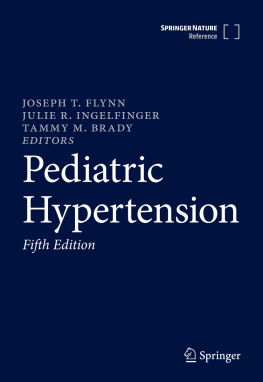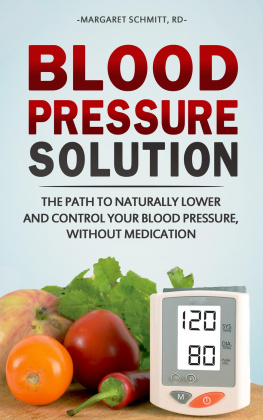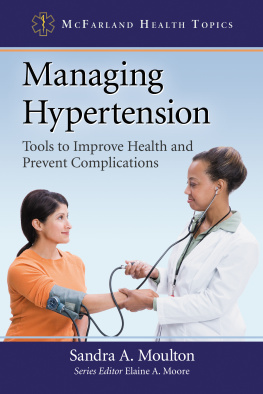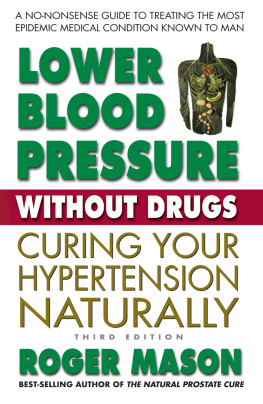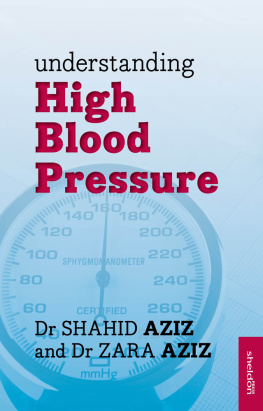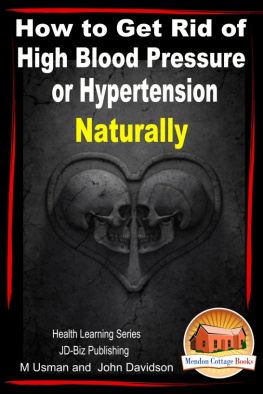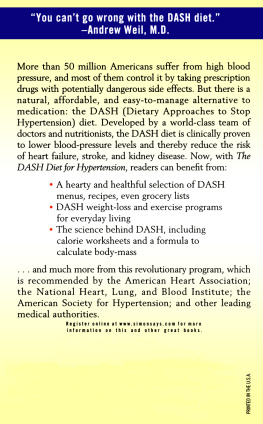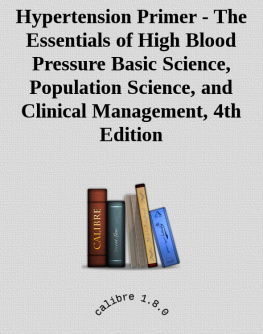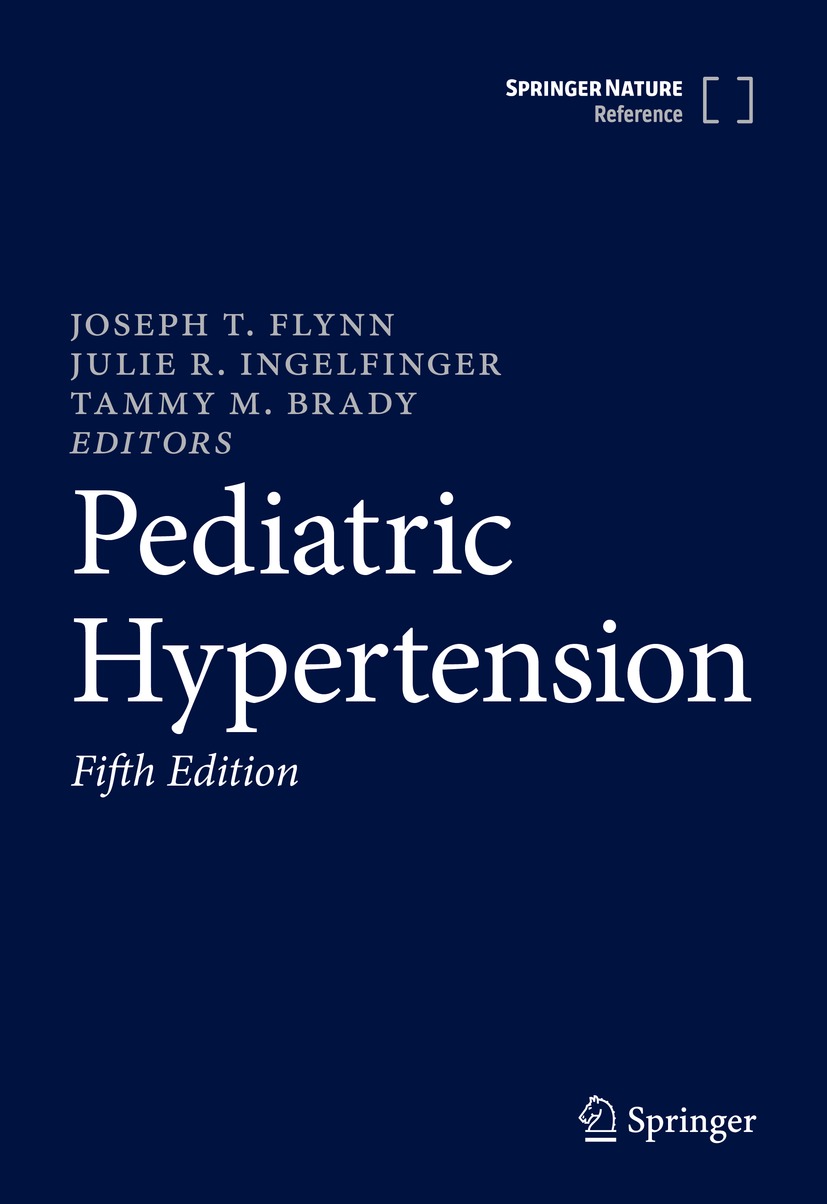Editors
Joseph T. Flynn , Julie R. Ingelfinger and Tammy M. Brady
Pediatric Hypertension
5th ed. 2023
With 104 Figures and 111 Tables

Logo of the publisher
Editors
Joseph T. Flynn
Department of Pediatrics, University of Washington School of Medicine, Seattle, WA, USA
Division of Nephrology, Seattle Childrens Hospital, Seattle, WA, USA
Julie R. Ingelfinger
Pediatric Nephrology Unit, Mass General for Children at MGB, Harvard Medical School, Boston, MA, USA
Tammy M. Brady
Department of Pediatrics Division of Pediatric Nephrology, Johns Hopkins University School of Medicine, Baltimore, MD, USA
ISBN 978-3-031-06230-8 e-ISBN 978-3-031-06231-5
https://doi.org/10.1007/978-3-031-06231-5
Springer Nature Switzerland AG 2018, 2023
This work is subject to copyright. All rights are reserved by the Publisher, whether the whole or part of the material is concerned, specifically the rights of translation, reprinting, reuse of illustrations, recitation, broadcasting, reproduction on microfilms or in any other physical way, and transmission or information storage and retrieval, electronic adaptation, computer software, or by similar or dissimilar methodology now known or hereafter developed.
The use of general descriptive names, registered names, trademarks, service marks, etc. in this publication does not imply, even in the absence of a specific statement, that such names are exempt from the relevant protective laws and regulations and therefore free for general use.
The publisher, the authors, and the editors are safe to assume that the advice and information in this book are believed to be true and accurate at the date of publication. Neither the publisher nor the authors or the editors give a warranty, expressed or implied, with respect to the material contained herein or for any errors or omissions that may have been made. The publisher remains neutral with regard to jurisdictional claims in published maps and institutional affiliations.
This Springer imprint is published by the registered company Springer Nature Switzerland AG
The registered company address is: Gewerbestrasse 11, 6330 Cham, Switzerland
Preface to the Fifth Edition
The importance of good cardiovascular health in adulthood is obvious but cannot be overemphasized, especially for children with health problems such as obesity and elevated blood pressure. This new edition of Pediatric Hypertension emphasizes data that have appeared over the last several years that are relevant to children with elevated blood pressure, as well as to children with obesity and other health challenges. Cross-sectional and longitudinal studies in large cohorts have led to notable advances in the field of pediatric hypertension. While there is still much work remaining, important knowledge gaps have been narrowed by new studies. Advances include improved understanding of which blood pressure thresholds lead to intermediate outcomes in children such as left ventricular hypertrophy, changes in carotid intima media thickness, and other markers as well as long-term cardiovascular outcomes in adults; enhanced assessment and interpretation of noninvasive measures of cardiovascular disease risk and early vascular aging; recognition of nontraditional cardiovascular disease risk factors in youth such as the role of early life stress; and the evolving description of the neurocognitive sequelae of hypertension. Further, the results of work over the last several years have demonstrated the importance of emergency preparedness and adaptability in the face of natural disasters and pandemics.
These substantial advancements, some of which challenge prevailing thought and have already prompted changes in professional society and expert clinical recommendations, are summarized in this Fifth Edition. As with the Fourth Edition, this current text is part of the Springer Major Reference Work program, which is available both in print and online, a format that allows for real-time updating. In addition to new chapters that address the topics noted above, this Edition provides updates to previously published chapters, including those exploring the epidemiology of hypertension; the genetic, perinatal, and lifestyle contributions to pediatric blood pressure and hypertension; secondary causes of hypertension and comorbidities; and the practical and pragmatic approaches to auscultatory, home, and ambulatory blood pressure measurement.
We are proud of the breadth of topics covered in this Edition of Pediatric Hypertension. It truly does take a village, and we are most grateful to our expert contributors, who shared their expertise and time to make this Edition as compelling and current as we believe it to be. We hope that this text will not only inform and educate existing clinicians and experts immersed in the field, but that it will also inspire students and trainees to choose a career that focuses on cardiovascular health promotion across the lifespan.
Joseph T. Flynn
Julie R. Ingelfinger
Tammy M. Brady
Seattle, USA Boston, USA Baltimore, USA
December 2022
Preface to the Fourth Edition
We are delighted to present this expanded fourth edition of Pediatric Hypertension, which is intended to capture and update the ongoing progress in childhood hypertension. There is a growing recognition that adult cardiovascular disease has its origins in childhood, supported by many recent studies. Additionally, the assessment of the short-term sequelae of childhood hypertension is providing new and important data, reviewed herein. Further, there are increasing numbers of studies that are delineating mechanisms of blood pressure elevation in the young. While the obesity epidemic appears to be leveling off (at least in the United States), it remains an important contributor to the higher prevalence of childhood hypertension reported in recent years; numerous epidemiologic studies have become available since publication of the third edition of this text and are detailed here. With publication of this new fourth edition, we hope to bring further focus on the importance of understanding and addressing the role of the obesity epidemic in pediatric hypertension.
As our publisher, Springer, has transitioned this text to its Major Reference Work program, which is available not only in print but also online, which allows for continual updating, we have been able not only to retain the topics covered in previous editions of Pediatric Hypertension but also to add new chapters that address additional and important aspects of childhood hypertension. One new chapter addresses the controversy over routine childhood blood pressure screening raised by the 2014 US Preventive Services Task Force Report. Obesity hypertension is now covered in two chapters, one focusing on mechanisms and the other on clinical aspects. Another important mechanism of cardiovascular disease, vascular dysfunction, is covered in a new chapter in the first section of the text. We also now address the important topic of home blood pressure measurement, while continuing to cover casual and ambulatory blood pressure measurement in detail. Expanded chapters on ESRD-related hypertension, substance-induced hypertension, hypertension in oncology patients, and hypertension in young adults should be of substantial interest to clinicians who care for such patients. We have also expanded the section on hypertension research with a new chapter on cohort studies and meta-analyses and their role in studying childhood hypertension. Finally, we have added a short Appendix summarizing the major changes of the 2017 American Academy of Pediatrics clinical practice guideline on childhood hypertension, which was completed as this new edition was in progress.

